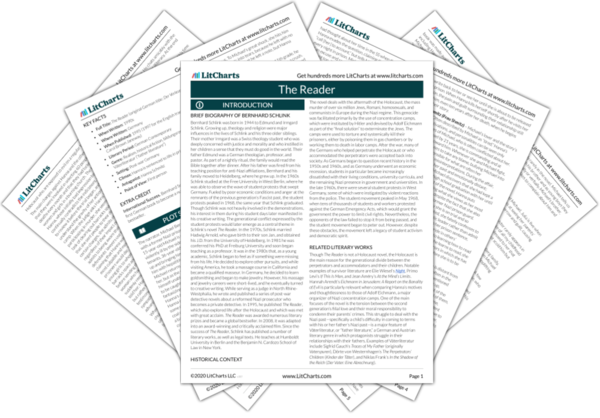Brief Biography of Bernhard Schlink
Bernhard Schlink was born in 1944 to Edmund and Irmgard Schlink. Growing up, theology and religion were major influences in the lives of Schlink and his three older siblings. Their mother Irmgard was a Swiss theology student who was deeply concerned with justice and morality and who instilled in her children a sense that they must do good in the world. Their father Edmund was a German theologian, professor, and pastor. As part of a nightly ritual, the family would read the Bible together after dinner. After his father was fired from his teaching position for anti-Nazi affiliations, Bernhard and his family moved to Heidelberg, where he grew up. In the 1960s Schlink studied at the Free University in West Berlin, where he was able to observe the wave of student protests that swept Germany. Fueled by poor economic conditions and anger at the remnants of the previous generation’s Fascist past, the student protests peaked in 1968, the same year that Schlink graduated. Though Schlink was not heavily involved in the demonstrations, his interest in them during his student days later manifested in his creative writing. The generational conflict expressed by the student protests would later emerge as a central theme in Schlink’s novel The Reader. In the 1970s, Schlink married Hadwig Arnold, who gave birth to their son Jan, and obtained his J.D. from the University of Heidelberg. In 1981 he was conferred his PhD at Freiburg University and soon began teaching as a professor. It was in the 1980s that, as a young academic, Schlink began to feel as if something were missing from his life. He decided to explore other pursuits, and while visiting America, he took a massage course in California and became a qualified masseur. In Germany, he decided to learn goldsmithing and began to make jewelry. However, his massage and jewelry careers were short-lived, and he eventually turned to creative writing. While serving as a judge in North Rhine-Westphalia, he wrote and published a series of post-war detective novels about a reformed Nazi prosecutor who becomes a private detective. In 1995, he published The Reader, which also explored life after the Holocaust and which was met with great acclaim. The Reader was awarded numerous literary prizes and became a global bestseller. In 2008, it was adapted into an award-winning and critically acclaimed film. Since the success of The Reader, Schlink has published a number of literary works, as well as legal texts. He teaches at Humboldt University in Berlin and the Benjamin N. Cardozo School of Law in New York.
Historical Context of The Reader
The novel deals with the aftermath of the Holocaust, the mass murder of over six million Jews, Romani, homosexuals, and communists in Europe during the Nazi regime. This genocide was facilitated primarily by the use of concentration camps, which were instituted by Hitler and devised by Adolf Eichmann as part of the “final solution” to exterminate the Jews. The camps were used to torture and systemically kill their prisoners, either by poisoning them in gas chambers or by working them to death in labor camps. After the war, many of the Germans who helped perpetrate the Holocaust or who accommodated the perpetrators were accepted back into society. As Germans began to question recent history in the 1950s and 1960s, and as Germany underwent an economic recession, students in particular became increasingly dissatisfied with their living conditions, university curricula, and the remaining Nazi presence in government and universities. In the late 1960s, there were several student protests in West Germany, some of which were instigated by violent reactions from the police. The student movement peaked in May 1968, when tens of thousands of students and workers protested against the German Emergency Acts, which would grant the government the power to limit civil rights. Nevertheless, the opponents of the law failed to stop it from being passed, and the student movement began to peter out. However, despite these obstacles, the movement left a legacy of student activism and democratic spirit.
Other Books Related to The Reader
Though
The Reader is not a Holocaust novel, the Holocaust is the main reason for the generational divide between the perpetrators and accommodators and their children. Notable examples of survivor literature are Elie Wiesel’s
Night, Primo Levi’s
If This Is Man, and Jean Améry’s
At the Mind’s Limits. Hannah Arendt’s
Eichmann in Jerusalem: A Report on the Banality of Evil is particularly relevant when comparing Hanna’s motives and thoughtlessness to those of Adolf Eichmann, a major organizer of Nazi concentration camps. One of the main focuses of the novel is the tension between the second generation’s filial love and their moral responsibility to condemn their parents’ crimes. This struggle to deal with the Nazi past—specifically a child’s difficulty in coming to terms with his or her father’s Nazi past—is a major feature of Väterliteratur, or “father literature,” a German and Austrian literary genre in which protagonists struggle in their relationships with their fathers. Examples of Väterliteratur include Sigfrid Gauch’s
Traces of My Father (originally
Vaterspuren), Dörte von Westernhagen’s
The Perpetrators’ Children (
Kinder der Täter), and Niklas Frank’s
In the Shadow of the Reich (
Der Vater: Eine Abrechnung).
Key Facts about The Reader
-
Full Title: The Reader (original German title: Der Vorleser)
-
When Written: 1990s
-
Where Written: Germany
-
When Published: 1995 (1997 for the English translation by Carol Brown Janeway)
-
Literary Period: German Contemporary
-
Genre: Realism, historical fiction, bildungsroman, Väterliteratur (“father literature”)
-
Setting: Post-war Germany
-
Climax: Hanna is sentenced to life in prison
-
Antagonist: Hanna Schmitz
-
Point of View: First person
Extra Credit for The Reader
